67kDa Laminin Receptor Antibody - #DF7710
| 製品: | 67kDa Laminin Receptor Antibody |
| カタログ: | DF7710 |
| タンパク質の説明: | Rabbit polyclonal antibody to 67kDa Laminin Receptor |
| アプリケーション: | WB IHC |
| 反応性: | Human, Mouse, Rat, Monkey |
| 予測: | Pig, Zebrafish, Bovine, Horse, Sheep, Rabbit, Dog, Chicken |
| 分子量: | 33 kDa; 33kD(Calculated). |
| ユニプロット: | P08865 |
| RRID: | AB_2841179 |
製品説明
*The optimal dilutions should be determined by the end user. For optimal experimental results, antibody reuse is not recommended.
*Tips:
WB: For western blot detection of denatured protein samples. IHC: For immunohistochemical detection of paraffin sections (IHC-p) or frozen sections (IHC-f) of tissue samples. IF/ICC: For immunofluorescence detection of cell samples. ELISA(peptide): For ELISA detection of antigenic peptide.
引用形式: Affinity Biosciences Cat# DF7710, RRID:AB_2841179.
折りたたみ/展開
34/67 kDa laminin receptor; 37 kDa laminin receptor precursor; 37/67 kDa laminin receptor; 37LRP; 40S ribosomal protein SA; 67 kDa laminin receptor; 67LR; Colon carcinoma laminin binding protein; Colon carcinoma laminin-binding protein; LAMBR; Laminin receptor 1; Laminin-binding protein precursor p40; LAMR 1; LamR; LAMR1; LBP; LBP/p40; LRP; LRP/LR; Multidrug resistance associated protein MGr1 Ag; Multidrug resistance associated protein MGr1Ag; Multidrug resistance-associated protein MGr1-Ag; NEM/1CHD4; p40; Ribosomal Protein SA; rpsA; RSSA_HUMAN; SA;
免疫原
A synthesized peptide derived from human 67kDa Laminin Receptor, corresponding to a region within C-terminal amino acids.
- P08865 RSSA_HUMAN:
- Protein BLAST With
- NCBI/
- ExPASy/
- Uniprot
MSGALDVLQMKEEDVLKFLAAGTHLGGTNLDFQMEQYIYKRKSDGIYIINLKRTWEKLLLAARAIVAIENPADVSVISSRNTGQRAVLKFAAATGATPIAGRFTPGTFTNQIQAAFREPRLLVVTDPRADHQPLTEASYVNLPTIALCNTDSPLRYVDIAIPCNNKGAHSVGLMWWMLAREVLRMRGTISREHPWEVMPDLYFYRDPEEIEKEEQAAAEKAVTKEEFQGEWTAPAPEFTATQPEVADWSEGVQVPSVPIQQFPTEDWSAQPATEDWSAAPTAQATEWVGATTDWS
種類予測
Score>80(red) has high confidence and is suggested to be used for WB detection. *The prediction model is mainly based on the alignment of immunogen sequences, the results are for reference only, not as the basis of quality assurance.
High(score>80) Medium(80>score>50) Low(score<50) No confidence
研究背景
Required for the assembly and/or stability of the 40S ribosomal subunit. Required for the processing of the 20S rRNA-precursor to mature 18S rRNA in a late step of the maturation of 40S ribosomal subunits. Also functions as a cell surface receptor for laminin. Plays a role in cell adhesion to the basement membrane and in the consequent activation of signaling transduction pathways. May play a role in cell fate determination and tissue morphogenesis. Acts as a PPP1R16B-dependent substrate of PPP1CA.
(Microbial infection) Acts as a receptor for the Adeno-associated viruses 2,3,8 and 9.
(Microbial infection) Acts as a receptor for the Dengue virus.
(Microbial infection) Acts as a receptor for the Sindbis virus.
(Microbial infection) Acts as a receptor for the Venezuelan equine encephalitis virus.
(Microbial infection) Acts as a receptor for the pathogenic prion protein.
(Microbial infection) Acts as a receptor for bacteria.
Acylated. Acylation may be a prerequisite for conversion of the monomeric 37 kDa laminin receptor precursor (37LRP) to the mature dimeric 67 kDa laminin receptor (67LR), and may provide a mechanism for membrane association.
Cleaved by stromelysin-3 (ST3) at the cell surface. Cleavage by stromelysin-3 may be a mechanism to alter cell-extracellular matrix interactions.
Cell membrane. Cytoplasm. Nucleus.
Note: 67LR is found at the surface of the plasma membrane, with its C-terminal laminin-binding domain accessible to extracellular ligands. 37LRP is found at the cell surface, in the cytoplasm and in the nucleus (By similarity). Colocalizes with PPP1R16B in the cell membrane.
Belongs to the universal ribosomal protein uS2 family.
研究領域
· Genetic Information Processing > Translation > Ribosome.
Restrictive clause
Affinity Biosciences tests all products strictly. Citations are provided as a resource for additional applications that have not been validated by Affinity Biosciences. Please choose the appropriate format for each application and consult Materials and Methods sections for additional details about the use of any product in these publications.
For Research Use Only.
Not for use in diagnostic or therapeutic procedures. Not for resale. Not for distribution without written consent. Affinity Biosciences will not be held responsible for patent infringement or other violations that may occur with the use of our products. Affinity Biosciences, Affinity Biosciences Logo and all other trademarks are the property of Affinity Biosciences LTD.


